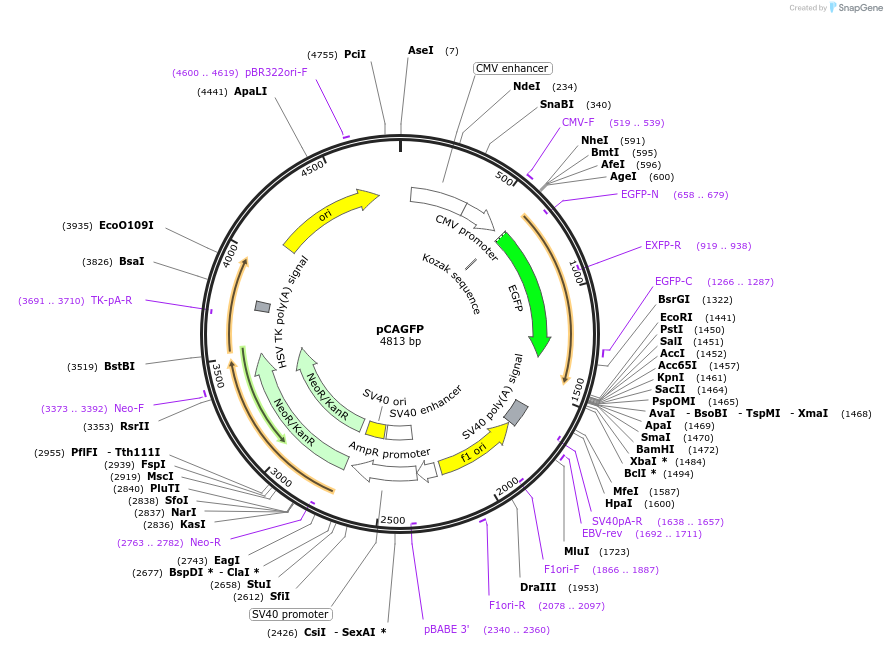-
Depositing Lab
-
Sequence Information
Ordering
| Item | Catalog # | Description | Quantity | Price (USD) | |
|---|---|---|---|---|---|
| Plasmid | 32748 | Standard format: Plasmid sent in bacteria as agar stab | 1 | $89 | |
Backbone
-
Vector backbonepmKate2-C
-
Backbone manufacturerClontech
- Backbone size w/o insert (bp) 3970
-
Vector typeMammalian Expression
-
Selectable markersNeomycin (select with G418)
Growth in Bacteria
-
Bacterial Resistance(s)Kanamycin, 50 μg/mL
-
Growth Temperature37°C
-
Growth Strain(s)DH5alpha
-
Copy numberHigh Copy
Gene/Insert
-
Gene/Insert nameGFP
-
Insert Size (bp)854
-
MutationS65T
- Promoter CMV
-
Tag
/ Fusion Protein
- DEVDFQGPCNDSSDPLVVAASIIGILHLILWILDRL (C terminal on insert)
Cloning Information
- Cloning method Restriction Enzyme
- 5′ cloning site NheI (not destroyed)
- 3′ cloning site EcoRI (not destroyed)
- 5′ sequencing primer CMV-F
- 3′ sequencing primer SV40pA-R
- (Common Sequencing Primers)
Resource Information
-
Articles Citing this Plasmid
Terms and Licenses
-
Academic/Nonprofit Terms
-
Industry Terms
- Not Available to Industry
Trademarks:
- Zeocin® is an InvivoGen trademark.
Depositor Comments
The gene for dark GFP (S65T) (referred to as GFP from this point forward) was created by PCR amplifying the GFP gene using a reverse primer that also encoded the 27 amino acid quenching peptide derived from the transmembrane region of influenza M2. A sequence encoding the linker (LEVLFQGP) was then inserted between the EGFP and M2 genes using the QuikChange mutagenesis (Stratagene) approach. The newly inserted linker sequence was then mutated to encode the caspase-7 cleavage recognition site (DEVDFQGP). The final sequence of CA-GFP protein is GFP with the fusion of DEVDFQGPCNDSSDPLVVAASIIGILHLILWILDRL at the C terminus. This construct was used for expression and purification of CA-GFP.
These plasmids were created by your colleagues. Please acknowledge the Principal Investigator, cite the article in which the plasmids were described, and include Addgene in the Materials and Methods of your future publications.
-
For your Materials & Methods section:
pCAGFP was a gift from Jeanne Hardy (Addgene plasmid # 32748 ; http://n2t.net/addgene:32748 ; RRID:Addgene_32748) -
For your References section:
Mechanism of a genetically encoded dark-to-bright reporter for caspase activity. Nicholls SB, Chu J, Abbruzzese G, Tremblay KD, Hardy JA. J Biol Chem. 2011 Jul 15;286(28):24977-86. Epub 2011 May 10. 10.1074/jbc.M111.221648 PubMed 21558267







